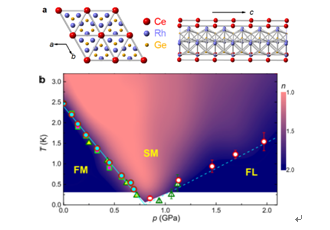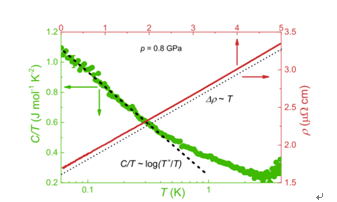Scientists discover a new setting for strange metals and quantum criticality
On 5th March 2020, Nature reported the discovery of a quantum critical point and strange metal behavior in the ferromagnet CeRh6Ge4, from a study led by Huiqiu Yuan at the Center for Correlated Matter and Department of Physics, Zhejiang University. The findings overturn the prevailing belief that ferromagnetic quantum critical points do not exist in nature, and establish the existence of an enigmatic “strange metal” phase in a new setting, that of ferromagnetic materials.
The study of phase transitions has been a cornerstone of modern physics, whether it be understanding the freezing of liquid water into ice, the alignment of electron-spins in a magnetic material, or what happened in the first fractions of a second after the big-bang. Remarkably, such a wide range of different phenomena show significant universal behaviors. These can generally be well described by the theory of classical phase transitions, where the properties near the transition are controlled by thermal fluctuations. Big differences however, are found when a magnetic transition is pushed to low temperatures, which can be achieved in some materials by applying a very large pressure. The point where the transition continuously reaches zero-temperature, is known as a quantum critical point. When a material sits close to such a quantum critical point, strong thermal fluctuations are not present, but instead there are quantum fluctuations, i.e. the quantum mechanical motion of particles arising from the Heisenberg uncertainty principle. Various fascinating features have been found near quantum phase transitions. One example is unconventional superconductivity, where magnetic fluctuations act as the ‘glue’ for the electron Cooper pairs which make up the superconducting fluid. Another is the emergence of an enigmatic strange metal phase in some quantum critical systems, where the electrical resistivity remains linear in temperature, even when cooled to temperatures within a few hundreths of a Kelvin of absolute zero.

Fig. 1. a, Crystal structure of CeRh6Ge4, where the Ce, Rh, and Ge atoms are shown in red, blue and yellow, respectively. b, Temperature-pressure phase diagram of CeRh6Ge4, where the ferromagnetic (FM), Fermi-liquid (FL) and strange metal (SM) phases are labelled. The ferromagnetic transition is continuously suppressed with pressure, revealing a ferromagnetic quantum critical point at a pressure of 0.8 GPa.

Fig. 2. Resistivity and specific heat of CeRh6Ge4, measured at the critical pressure of 0.8 GPa. The resistivity shows a linear in temperature dependence over two orders of magnitude, while the specific heat increases logarithmically with decreasing temperature. These are hallmarks of the strange metal phase.
Quantum critical points and strange metal behavior have generally been associated with antiferromagnetism, that is magnetic order where the electron-spins on adjacent atoms point in different directions. In antiferromagnets, the electron-spins can be thought of as being quantum mechanically entangled, which has been considered a vital ingredient for strange metal behavior. In contrast, in ferromagnets the spins all align along the same direction. As such, ferromagnets were not expected to host such entanglement, and indeed scientists had long predicted that quantum critical points should not occur in ferromagnetic materials.
A recent study published in Nature however, overturns both of these notions. A team of scientists at Zhejiang University, in collaboration with researchers from the Max Planck Institute for Chemical Physics of Solids in Dresden, measured the electrical resistivity, heat capacity and ac magnetic susceptibility of the ferromagnetic material CeRh6Ge4, under applied pressure at very low temperatures. They found that the ferromagnetic transition temperature smoothly decreases when larger and larger pressures are applied, until it entirely disappears at a quantum critical point (Fig. 1). In this region they find that CeRh6Ge4 behaves like a strange metal, where the resistivity is remarkably linear in temperature down to extremely low temperatures, while the specific heat increases logarithmically upon cooling (Fig. 2). This type of behavior is remarkably similar to the strange metal phase of the copper oxide high temperature superconductors, the nature of which is one of the long-standing mysteries of condensed matter physics.
To understand the puzzling results, the experimentalists teamed up with theoretical physicists at Rutgers University. They argue that the magnetic anisotropy in CeRh6Ge4 plays an important role in the occurrence of the strange metal behavior and a ferromagnetic quantum critical point. The key idea being that the same magnetic anisotropy which forces the electron-spins to align within a particular crystal plane in the material, also injects quantum-entanglement into the ferromagnet, allowing for the expected prohibition of a ferromagnetic quantum critical point to be bypassed. This scenario requires that the electron-spins remain localized within the ferromagnetic phase, but become delocalized and join the Fermi sea at the quantum critical point (Fig. 3).

Fig. 3. Illustration of the proposed evolution of CeRh6Ge4 under pressure, from a ferromagnetic phase at ambient pressure, to a strange metal, and then a heavy fermion ground state.
These findings therefore, give important clues about the role played by quantum entanglement in strange metals. They also open up a whole new category of quantum critical materials in ferromagnetic systems, which it is hoped will show an equally rich and diverse range of novel physics as their antiferromagnetic counterparts. In particular, quantum criticality and strange metal behavior have frequently been found together with unconventional superconductivity. Although they didn’t see experimental signatures of superconductivity in their present study, the authors are optimistic that novel superconducting phases can be found in this new class of materials.
Research team
This work was performed by researchers at the Center for Correlated Matter and Department of Physics at Zhejiang University, as well as the Department of Physics and Astronomy at Rutgers University, the Max Planck Institute for Chemical Physics of Solids in Dresden, and the Department of Physics at University of London at Royal Holloway. Bin Shen and Yongjun Zhang, PhD students from Zhejiang University, are co-first authors. Huiqiu Yuan and Michael Smidman from Zhejiang University, and Piers Coleman from Rutgers University and University of London, are co-corresponding authors. Huiqiu Yuan conceived the study and led the project. The project received support from the National Key R&D Program of China, the National Natural Science Foundation of China, and the Science Challenge Project of China.
Link to the published paper:
For more information, please contact:
| Prof. Huiqiu Yuan | Prof. Michael Smidman |
|
Executive Deputy Director,
|
Center for Correlated Matter
|
|
Center for Correlated Matter
|
Zhejiang University
|
|
Zhejiang University
|
|
|
Tel/Fax: +86 571 88981363
|
Tel/Fax: 0571-88208579
|
|
Email: hqyuan@zju.edu.cn
|
Email: msmidman@zju.edu.cn
|



